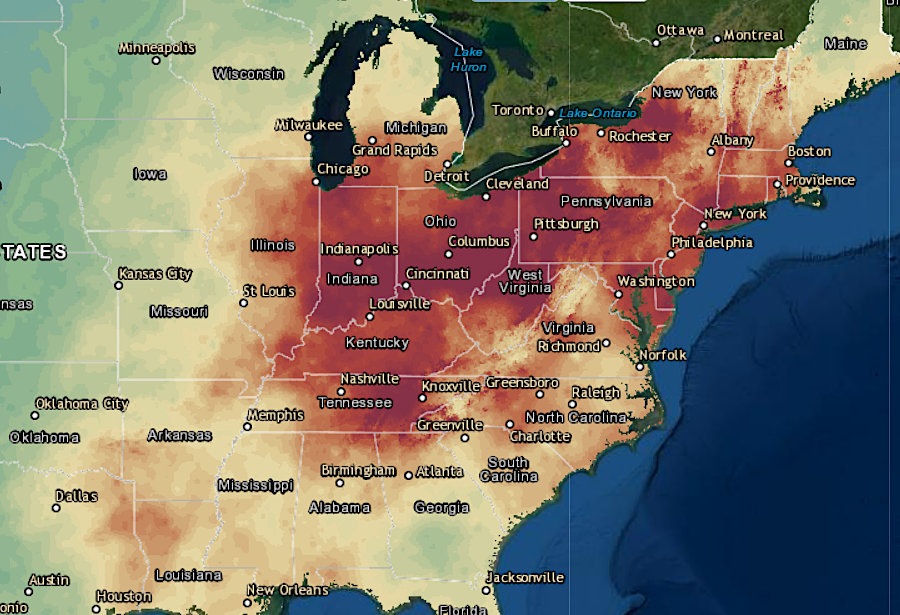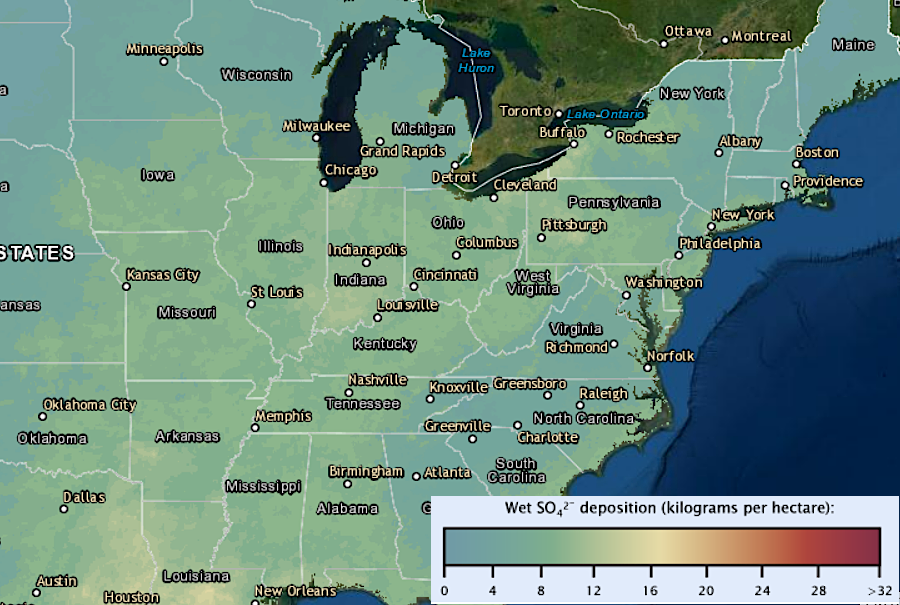

Wet sulfate (SO42-) deposition in the contiguous U.S., 1989-1991 (top) and 2014-2016 (bottom)
Source: Environmental Protection Agency (EPA), Acid Rain (Exhibit 1)


Wet sulfate (SO42-) deposition in the contiguous U.S., 1989-1991 (top) and 2014-2016 (bottom)
Source: Environmental Protection Agency (EPA), Acid Rain (Exhibit 1)
Add enough sulfur dioxide from power plants, nitrogen oxides from car exhausts, and ammonium from farming operations to water vapor in the atmosphere, and the resulting rain will be acid enough to leach calcium from soils and vegetation.
Acid rain (and snow and fog) is changing the chemistry of our uplands, wetlands, and open waters. It is killing the spruces and sugar maples on the land, as well as poisoning the fish and other life in the ponds and streams. The trees lose some of their vigor and become vulnerable to insects, diseases, and especially to freezing temperatures. In fish, the osmotic control to manage the saltwater/freshwater balance is affected.
Congress passed the Clean Air Act in 1963, strengthened it in 1970, revised it in 1977, and added a new set of Clean Air Act Amendments in 1990. Based on that law, the Environmental Protection Agency (EPA) sets National Ambient Air Quality Standards (NAAQS) to protect public health and welfare. In most cases, the states develop and enforce them through State Implementation Plans (SIP's). Lead, carbon monoxide, and ground level ozone concentrations have been reduced substantially.
EPA has the authority to reduce the Federal transportation funding provided to a state if it fails to meet its Clean Air Act deadlines. Nearby states can also help enforce the law, if a state's air quality is reduced by pollution from another state. The impacted state may petition EPA (under section 126 of the Clean Air Act) to set mandatory emissions limits for specific sources of pollution in the other state. The Ozone Transport Assessment Group was effective in forcing multiple states to agree to common standards and deadlines.
Acid rain controls were established in Title IV of the Clean Air Act Amendments of 1990. That law set limits to sulfur dioxide limits, but allowed utilities to trade emissions rights if they managed to reduce their pollutants below the required level. This created a market for permission to pollute in sulfur dioxide, but the process was effective in reducing sulfur dioxide emissions further and faster than through standard government command-and-control mandates. Emission rights for nitrogen oxides are not traded, and that pollutant has not been reduced as fast.1
As described by the Government Acccountabilty Office in 2000:2
Despite some success in reducing sulfur dioxide emissions, the existing controls might not restore the impaired natural environment in the Northeast to pre-acid rain conditions until the middle of the century... if then.2 According to a summary of , published in BioScience (vol. 51, no. 3, 2001):
Virginia is at the edge of these studies. The wind carries pollution from the Ohio River Valley into New England, causing greater impacts there. Republican senators from New England were supportive of environmental protection for a reason when Virginia's two Republican senators were not nearly as "green." Political stances by elected officials are not independent of the socio-economic or the natural environment.